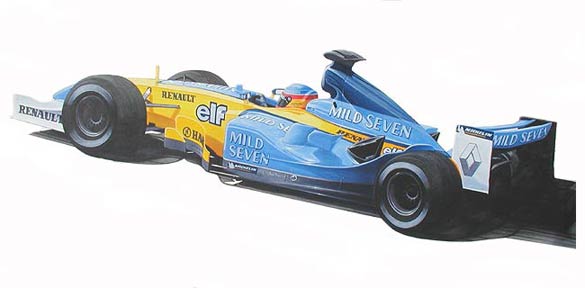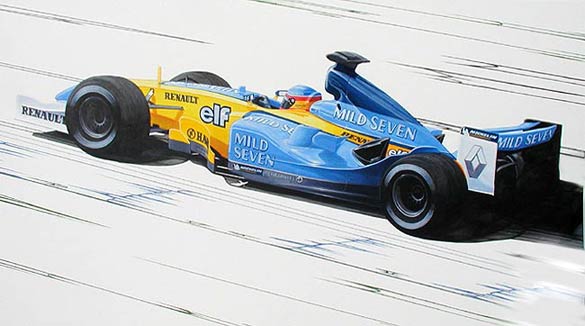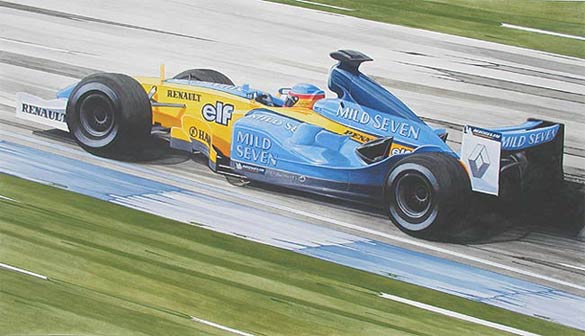
Atlas F1 GP Illustrator
Painting is not only about talent, and the creation process is far more complex that it may appear. There are endless rules, and several do's and don't's that escape the eye of the casual viewer. Atlas F1's GP illustrator Bruce Thomson brings you closer to the experience of creating a piece of art
Finally, I'm ready to get into the background. I've been a little concerned about this for a while.In the colour study I've handled the background really graphically, with the road being all but eliminated except for some graphic streaks. The more I've worked on the painting, the more I've begun to think that this will not work effectively. The car itself is less graphic than I had intended, as I've become caught up in the details and have cheated it towards a certain kind or realism. I'm not too concerned about this, and I'll proceed as if I'm going to do the painting as per the colour rough. If I decide not to, it will be easy to adjust at that time.
First thing I have to do for the background is to get the linework in. For this I use a ruling pen. A ruling pen is something like a pen nib into which you can load paint. I use it for this part of the painting because I have a lot of straight lines to draw and it simply becomes to time-consuming and inaccurate to draw with a triple "0" brush. If I use the ruling pen I am ensured of accuracy, as I can use a ruler with it. So, I paint in hard lines, using black cut with a little cadmium red for the road, chromium oxide green for the grass and a mixture of cerulean blue, twilight and light blue violet for the curbing. I go back into the linework with a brush once I've completed work with the ruling pen. I want to soften up the lines a little and make them appear a little bit less mechanical. The result still looks a little harsh, especially when you have the car to contrast it to, but with added tone, this will be softened up considerably. This is the result of the work with the ruling pen.:
I start to add tone by layering in thin washes of chromium oxide green cut with bronze yellow (to pick up the yellow in the car) in the grass areas. Immediately I see that my concerns about my concept of the piece born out; without tone in the road, the painting simply looks unfinished. As I've said, I'm not too concerned about this, as it will be easy to rectify, but it does highlight something I've found in the past, which is that what works on a small scale in a rough, doesn't always translate well to a finished painting.
What I will do then, is to add tone to the road. I'll also be working a little bit darker than I had originally intended, which will mitigate the strength of the outlines I've drawn. The concept of the painting will still be the same, it will simply be less graphic than I had originally intended. The graphic aspect of it will still be visible in the line treatments I've used, but the tone will soften the harshness of the line. Again, it's not exactly what I had originally intended, but these things seem to develop a life of their own, and you fight against that at your peril.
Throwing in the background is time consuming and somewhat tedious. After all of the tight and demanding work in the body of the car, you'd think I'd welcome the opportunity to throw in some broad strokes, but I don't. In truth, I find this part of the painting boring, and I have to be careful to avoid rushing it off. I try to hone my attention by addressing the background in small pieces, building it up inch by inch, section by section. First I look after the grass, starting with the area at the bottom of the painting which I've done in seven different sections, then the top. Next up is the curbing, which splits itself rather obviously into three and a half different areas. Finally I get into the roadway and using a thinned blend of mars black, cadmiun red, bronze yellow and twilight, I begin to build it up.
Unfortunately though, I've run out of time. I had hoped to finish the painting this week, but several things conspired to keep me from doing so, and I am left about a day short. This is actually a very tricky part of the painting, because it's easy to work a painting too long and over-detail it. Knowing when to stop is a real talent, and something I try to keep at the top of my mind as soon as I begin to get near the end of the work. Anyway, looking at it, I can tell I'm not quite at the end yet. The roadway especially needs to be given a little more tone, and I'm seeing the odd thing I missed on the car (like outlining Bibendum in the "Michelin" logo). I'll also have to get rid of the white streaks in the grass which had originally been intended as part of the graphic nature of the piece, but which are now simply looking distracting. Here's where I've got to this week:
Another day, and one more abbreviated issue of this text, and we should be looking at the finished painting. This week I've spent about 18 hours on the painting, bringing the total number of hours to 80.
In the previous chapter, I finished by saying that I'd be touching up the car a little, although by and large, it was finished. I underestimated when I said "a little" and ended up spending another four hours on the car before launching into the background. Even with that, there are still a few things to touch up on the car before it's done. I'm getting to the point (with the car itself, anyway) where the law of diminishing returns seems to be kicking in. Certainly, the progress here seems less than obvious. However, what I concentrated on was cleaning up any unfinished areas, including the helmet and cockpit the Michelin logos (which were roughed in but not complete), the Renault logos, (needed to be darkened), and deepening of the shadows and reflections in the car body. Here it is:



|
Contact the Author
Contact the Editor |
Please Contact Us for permission to republish this or any other material from Atlas F1.
|
Volume 10, Issue 18
Articles
Every Other Sunday
The Paint Job VI
2004 Spanish GP Preview
2004 Spanish GP Preview
Spanish GP Facts & Stats
The F1 Trivia Quiz
Columns
Rear View Mirror
Bookworm Critique
On the Road
Elsewhere in Racing
The Weekly Grapevine
> Homepage |